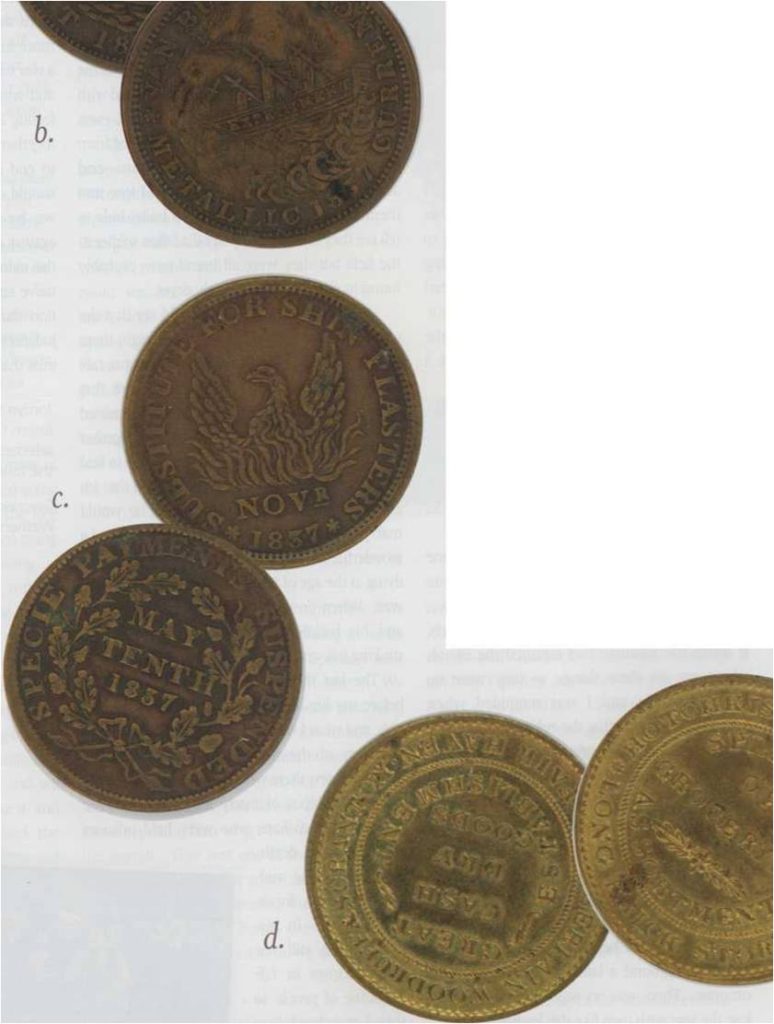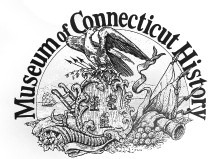By David Corrigan.
In 1837 the Waterbury firm of J.M.L. and W.H. Scovill, operated by brothers James and William Scovill, produced a series of copper tokens whose purpose was to satirize the economic policies of President Andrew Jackson and his successor Martin Van Buren. Manufactured in the midst of the Panic of 1837, the worst economic depression the United States had experienced, these tokens were nearly identical in size and weight to the large copper cents then being minted by the United States. They came to be accepted as legal tender as the depression deepened and gold, silver, and, eventually, copper coins disap¬peared from circulation due to bank failures and hoarding by the public.

h. Merchant’s token, J.M.L. & W.H. Scovill, 1837. The token advertises dry-goods purveyor Chamberlain Woodruff & Scranton of Fairhaven on one side and grocers Hotchkiss Hall & Platts on the other.
C. Hard times token, J.M.L. & W.H. Scovill, 1837. “Shin plasters” was the satirical name given to the worthless paper money issued by many banks in the 1830s.
d. Hard times token, J.M.L. & W.H. Scovill, 1841. Daniel Webster’s support for the Constitution and the United States Bank is depicted on one side, and the Van Buren administration’s continuation of what Whigs considered the dangerous financial “experiments” of Andrew Jackson is satirized on the reverse.
These tokens are known to American numis¬matists and collectors as “hard times tokens.” That desig¬nation highlights their unintended use as currency but obscures their original intent as political satire and propaganda and their role as examples of the emerging prowess of the metalworking industry in the Waterbury area.
National, state, and local politics in the 1830s and 1840s revolved around the back-and-forth struggle for power between Whigs and Democrats. The Whigs were the political heirs of the Federalists, while the Democrats had evolved from the Jeffersonian Republicans. Unalterably opposed to Andrew Jackson and his perceived tyranny and usurpation of power since his election in 1828, the former Federalists were compelled to re-brand themselves as “Whigs,” in emulation of earlier British politicians opposed to royal abuses of power, after his re-election in 1832. Between 1833 and 1855, Connecticut voters overwhelmingly supported Whig presidential candidates, while sending six Whigs and five Democrats to the United States Senate. In addition, six Whigs and six Democrats served as governor, and control of the legislature also changed hands frequently.
The Whigs’ animosity toward Jackson centered on his economic policies, which they viewed as dangerous “experiments.” After his re-election, Jackson continued his attack upon the Second Bank of the United States, which was fueled by his mistrust of a centralized, private bank. In 1836 Jackson allowed the Bank’s charter to expire and ordered the withdrawal of U.S. government funds from its coffers. These funds were instead deposited with smaller, local banks, which, in turn, funded vastly increased levels of speculation in U.S. government land, notably in western states such as Michigan and Missouri. In July 1836, Jackson issued his “Specie Circular” stipulating that all purchases of government land were to be made in specie- gold and silver coinage—no: paper money or banknotes, which supporters of hard currency derisive¬ly referred to as “shin plasters,” This edict underwent the speculative boom, begun in the 1820s, that had been fueled by the overabundance of paper money issued by banks without enough gold or silver to back it up. Unfortunately for Martin Van Buren, elected president in 1836 and promising to continue Jackson’s economic policies. New York banks stopped all transactions using gold or silver on May 10, 1837, which led to the virtual disappearance of such coins from circulation. Over the next five years, economic conditions worsened. More than 600 banks failed, and unemploy¬ment reached unprecedented levels. Specie payments did not fully resume until 1842.
It is against this background that the Scovill & Co. hard times tokens can best be understood. In addition to running the largest brass-button manufactory in Connecticut, both Scovill brothers were Whigs. Janies was the more active politically running for state senator three times, winning election for one term ui 1835. He represented Waterbury at the Convention of Delegates of the Connecticut Whig Party in 1837 and served as vice president of that party in 1838 and 1839. William was nominated for state representative by the Waterbury Whigs in but, citing family health issues, later declined the nomination’
irother stood in for him but was unsuccessful in his election bid. In 1847 William was one of four delegates from Waterbury to the Whig party’s state convention.

Current research identifies more than 600 varieties of hard times tokens, about half of which are positively identified as being made by 12 makers. Of these 12 makers, Scovill & Co. was the most prolific, producing 90 varieties. The high quality of the Scovill tokens is directly attributable to the skill of William Eaves, a die-cutter from Birmingham, England.
In 1888, H.N. Johnson, head of the department of numismatics of the Western Reserve and Northern Ohio Historical Society, commented, “These tokens were issued from the Waterbury, Conn., button factory of the Scovilles (sic)…. They passed as currency, being of good metal and weight, and though of insignificant nominal value as compared with the bank bills of the day, they are yet occasionally found in circulation….” The resumption of specie payments by banks in 1842 drastically reduced the need for hard times tokens as currency. Many remained in circulation, but they gradually disappeared, though many tokens in both private and public collections show evidence of much usage. The Scovill hard times tokens are vivid reminders of the political passions of the 1830s and of the and manufacturing skills that would later come to define Connecticut. All tokens are from the collection of the Museum of Connecticut History
